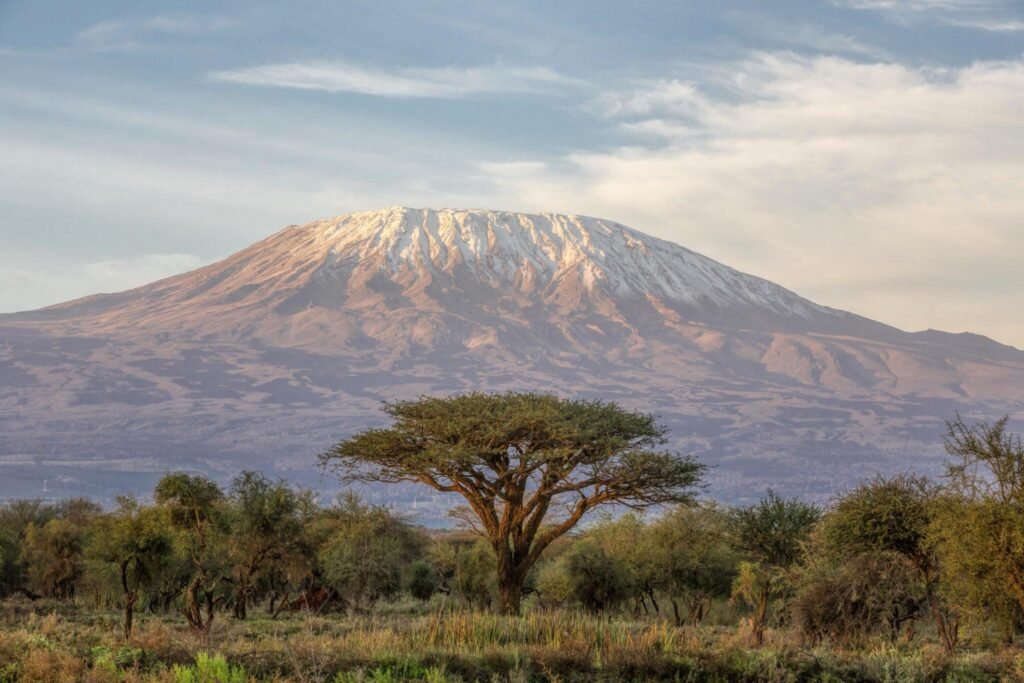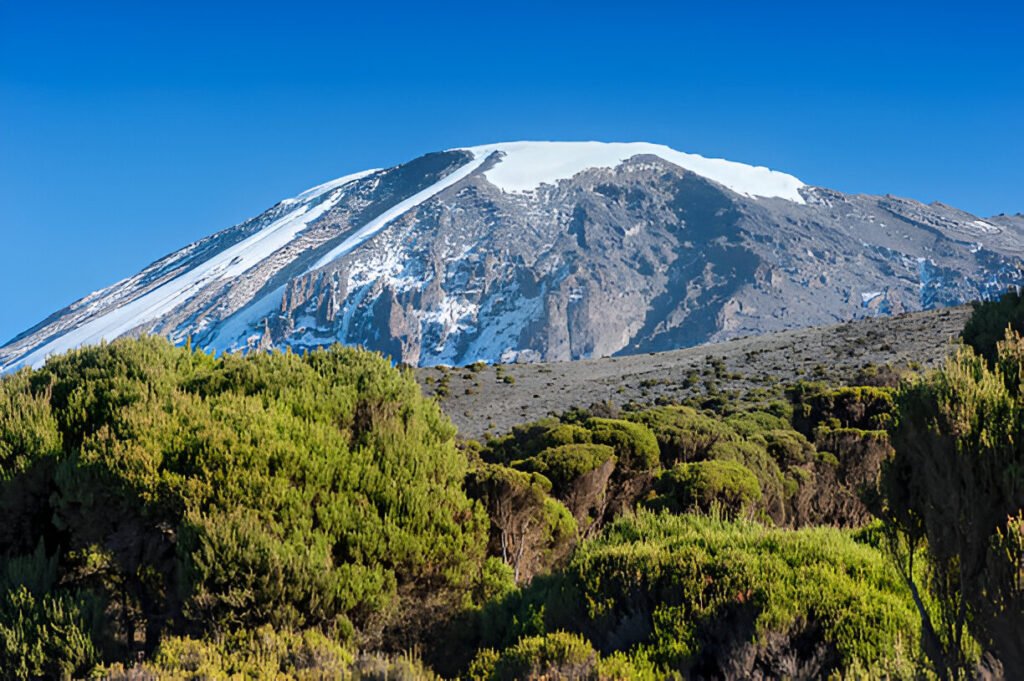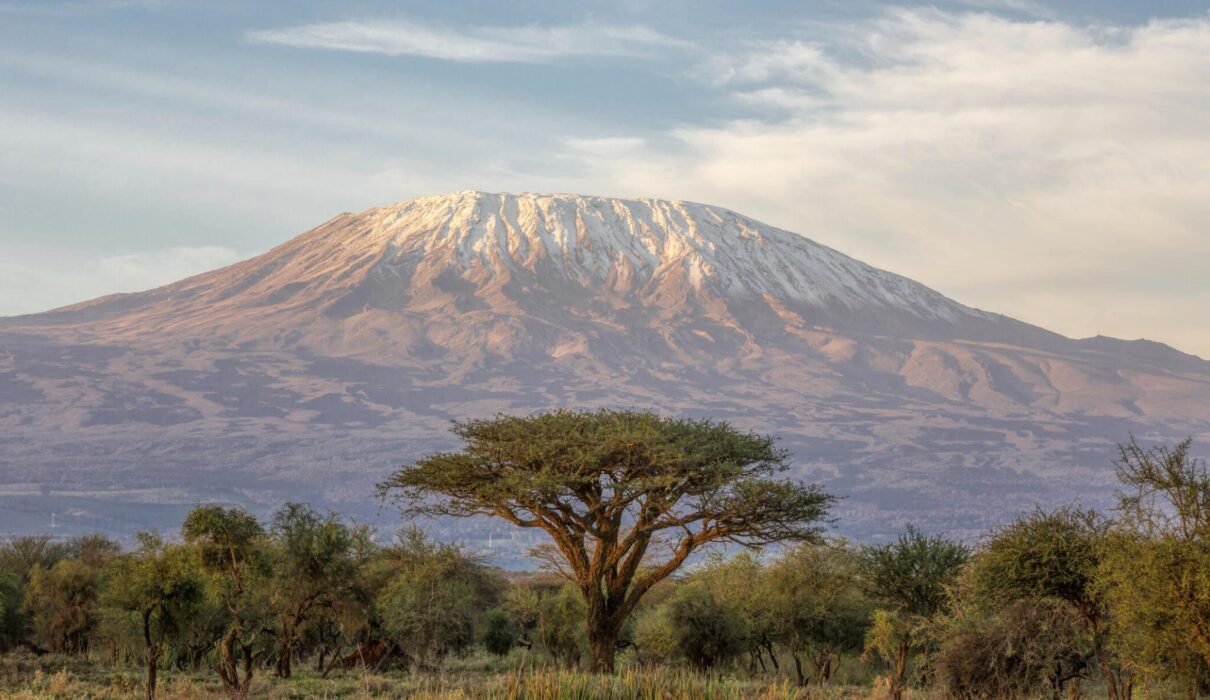Where Is Kilimanjaro Located: Mount Kilimanjaro, the highest peak in Africa, is one of the most iconic mountains in the world. Its snow-capped summit rises majestically above the plains of Tanzania, drawing adventurers and nature lovers from around the globe. But exactly where is Kilimanjaro located? In this guide, we’ll explore the mountain’s location, geography, surrounding environment, and why it’s such a popular destination for climbers
Learn more about Kilimanjaro treks and tours

Where Is Kilimanjaro Located ? : Kilimanjaro’s Exact Location
Mount Kilimanjaro is located in northeastern Tanzania, close to the border with Kenya. It lies about 200 miles south of the equator, providing a unique environment where both tropical and alpine climates coexist. The mountain itself is part of Kilimanjaro National Park, a UNESCO World Heritage Site
- Coordinates: 3°04′33″ S latitude, 37°21′12″ E longitude.
- Nearest Town: Moshi is the closest large town, serving as the main gateway for climbers and tourists visiting Kilimanjaro
Get more information about Kilimanjaro National Park.
Where Is Kilimanjaro Located ?: How to Reach Mount Kilimanjaro
Most visitors access Mount Kilimanjaro through Kilimanjaro International Airport (JRO), which is conveniently located between the towns of Moshi and Arusha. From here, it’s just a short drive to the national park entrance.
- By Air: Flights from major hubs like Dar es Salaam, Nairobi, and international locations fly directly into Kilimanjaro International Airport.
- By Road: If you’re traveling from other parts of Tanzania, buses and private transfers are available from Arusha, Dar es Salaam, and other major cities.
Learn more about how to get to Kilimanjaro.
Where Is Kilimanjaro Located ? : Geography of Mount Kilimanjaro
Mount Kilimanjaro is a stratovolcano composed of three distinct cones: Kibo, Mawenzi, and Shira. Among these, Kibo is the highest and houses the famous Uhuru Peak, which stands at 5,895 meters (19,341 feet) above sea level, making it the tallest free-standing mountain in the world.
Kilimanjaro’s Three Volcanic Cones
- Kibo: The highest and most famous summit where trekkers aim to reach the iconic Uhuru Peak.
- Mawenzi: A rugged, jagged peak to the east of Kibo, often seen as climbers ascend.
- Shira: A lower, extinct volcanic cone that forms a plateau at the base of the mountain.
Explore the volcanic history of Kilimanjaro.
Where Is Kilimanjaro Located ? : Climate Zones of Mount Kilimanjaro
Kilimanjaro’s location near the equator means it experiences varied weather patterns across its different altitudinal zones. There are five distinct climate zones as you ascend the mountain:
- Cultivation Zone (800m – 1,800m): The base of Kilimanjaro, characterized by farms and villages.
- Rainforest Zone (1,800m – 2,800m): Dense tropical forests, rich with wildlife, including monkeys and birds.
- Heath and Moorland Zone (2,800m – 4,000m): Shrubby vegetation and large rock formations.
- Alpine Desert Zone (4,000m – 5,000m): Arid and dry with extreme temperature changes.
- Arctic Zone (5,000m – 5,895m): Freezing cold with snow and ice fields near the summit.
Learn about Kilimanjaro’s diverse climate zones.

5. What Makes Kilimanjaro Unique?
Kilimanjaro is often referred to as “The Roof of Africa” because it is the highest peak on the continent. What makes Kilimanjaro so unique is that it is a free-standing mountain, meaning it is not part of a mountain range. This creates the spectacular contrast between the flat savannah and the towering snow-capped peak, visible from hundreds of miles away.
Additionally, Kilimanjaro offers one of the few opportunities to summit such a high mountain without technical climbing skills. Trekkers of all levels, with proper preparation, can successfully reach the summit.
Discover why Kilimanjaro is a bucket-list destination for adventurers.
6. Best Time to Climb Mount Kilimanjaro
Mount Kilimanjaro can be climbed year-round, but the best time to visit is during the dry seasons when the weather is more predictable, and the trails are in good condition.
Optimal Climbing Seasons
- June to October: The main dry season and the best time for climbing due to clear skies and moderate temperatures.
- January to March: Another popular time, especially for those who prefer fewer crowds.
Avoid the rainy seasons (April to May, and November), as the trails can become muddy and challenging.
Check out the best time for your Kilimanjaro trek.
7. Cultural Significance of Kilimanjaro
Mount Kilimanjaro holds deep cultural significance for the local Chagga people, who live around the base of the mountain. The Chagga view Kilimanjaro as sacred, and it plays a central role in their myths, traditions, and agricultural practices. Many climbers pass through villages where the Chagga still live and work, offering an opportunity to learn about their unique culture.
Chagga Villages and Traditions
- Moshi Town: A hub for climbers, where many Chagga people live and work.
- Chagga Farming: Known for their efficient farming techniques, particularly with bananas and coffee.
Learn more about the Chagga people and their connection to Kilimanjaro.
8. Why Kilimanjaro Is a Top Trekking Destination
Kilimanjaro is a top destination for climbers worldwide for several reasons:
- Non-Technical Climb: Kilimanjaro does not require technical climbing skills, making it accessible to trekkers of various experience levels.
- Varied Routes: There are several routes to the summit, including the popular Machame, Marangu, and Lemosho routes, each offering different levels of difficulty and scenic beauty.
- Diverse Ecosystem: The journey takes climbers through lush rainforests, alpine deserts, and finally, to a snowy summit, showcasing one of the most diverse trekking experiences.
Find out more about the different Kilimanjaro routes.
9. How Difficult Is It to Climb Kilimanjaro?
While Kilimanjaro is not a technical climb, it’s important to note that the ascent is still physically demanding. The biggest challenge climbers face is the altitude. As you ascend, the air becomes thinner, which can lead to altitude sickness. Proper acclimatization and slow, steady progress are essential to successfully reach the summit.
Tips for Success
- Go Slow: Take your time to allow your body to adjust to the altitude.
- Hydration: Drink plenty of water to avoid dehydration.
- Physical Training: Prepare months in advance with cardio and endurance training.
Read more about the challenges of climbing Kilimanjaro.
10. Preparing for Your Kilimanjaro Climb
If you’re planning to climb Kilimanjaro, it’s crucial to be well-prepared. Here are some key things to consider before embarking on your journey:
Gear and Equipment
- Clothing Layers: Be prepared for both hot and cold weather. Pack moisture-wicking base layers, insulated mid-layers, and a waterproof jacket.
- Footwear: Comfortable, waterproof hiking boots are essential for trekking on Kilimanjaro’s rugged terrain.
- Sleeping Bag: Bring a high-quality sleeping bag rated for freezing temperatures.
Get a full packing list for your Kilimanjaro climb.
Acclimatization
- Choose routes with longer durations to allow for better acclimatization. The Lemosho and Northern Circuit routes are highly recommended for those concerned about altitude sickness.
Learn more about acclimatization strategies.
11. Wildlife Around Mount Kilimanjaro
Kilimanjaro is home to diverse wildlife species that vary depending on the altitude zone. In the lower rainforest zone, climbers may encounter blue monkeys, colobus monkeys, and various birds. As you ascend, the wildlife becomes sparser, but you may still spot small mammals like hyraxes in the alpine zones.
- Birdwatching: Kilimanjaro’s rainforests are a haven for birdwatchers, with over 180 species recorded, including turacos and hornbills.
Explore more about wildlife in Kilimanjaro National Park.
12. Conservation and Sustainable Tourism
Kilimanjaro’s environment is delicate, and it’s essential for climbers to follow sustainable practices. Park authorities and local operators are working hard to preserve Kilimanjaro’s natural beauty through conservation efforts. Climbers are encouraged to minimize waste, use local guides, and follow Leave No Trace principles.
Sustainability Tips for Climbers
- Stay on Marked Trails: Avoid disturbing wildlife and plant life.
- Carry Out Trash: Ensure you bring all waste down the mountain.
- Support Local: Choose local guides and services to help the community.
Learn about Kilimanjaro’s conservation efforts here.
Where Is Kilimanjaro Located ? : Conclusion
Mount Kilimanjaro is not only Africa’s tallest mountain but also a symbol of adventure, perseverance, and natural beauty. Whether you’re planning to trek to the summit or explore the surrounding areas, understanding where Kilimanjaro is located and how to prepare for your climb is essential for a successful trip. From the bustling town of Moshi to the majestic summit of Uhuru Peak, Kilimanjaro offers an unforgettable experience for nature lovers and adventurers alike.
For more details on planning your Kilimanjaro adventure, visit Kilimanjaro Climb Specialist or Eddy Tours & Safaris.

